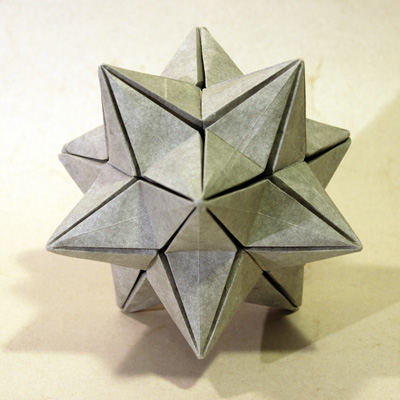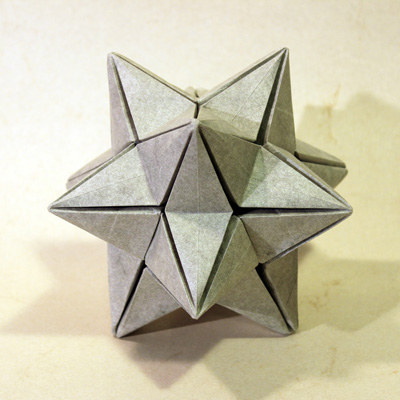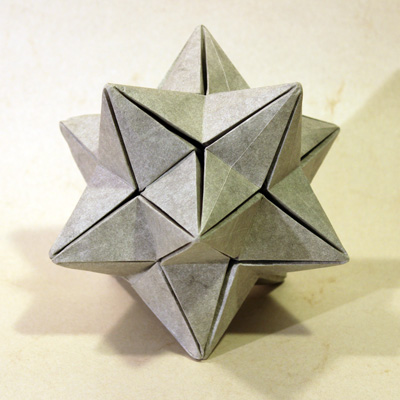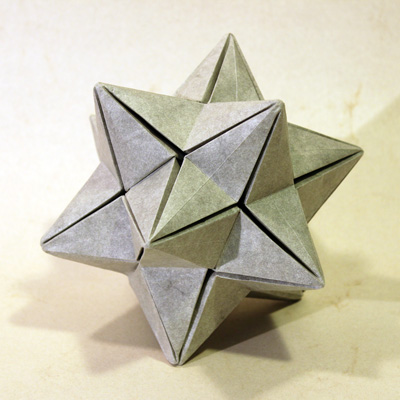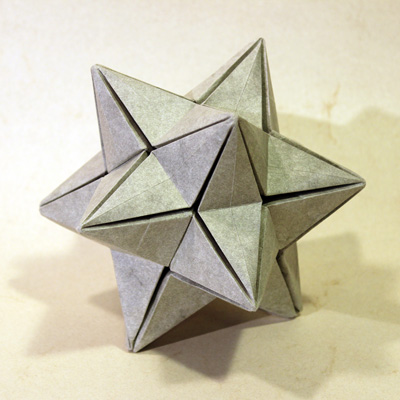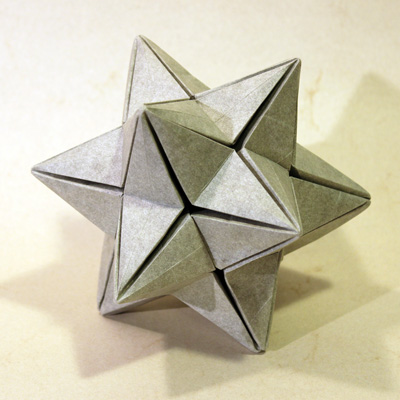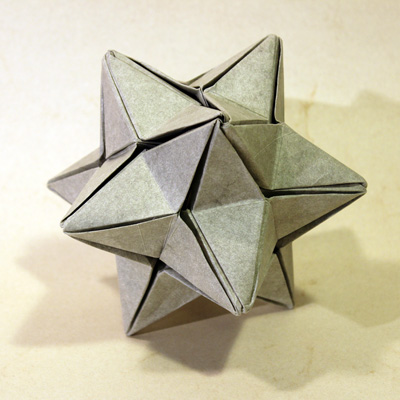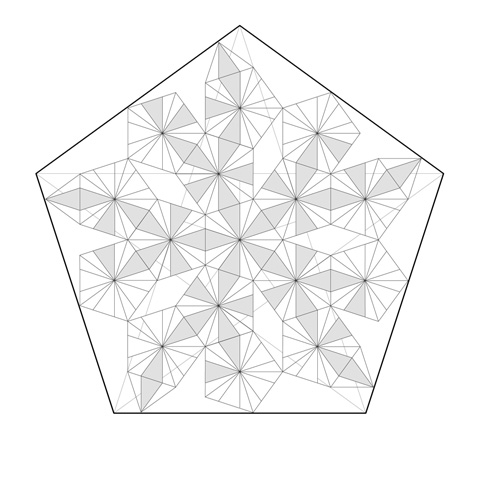As mentioned previously, I had a great OUSA convention this year. If you’re interested there are lots of pics online here. One of the things that made it great for me is I had a lot of new models: Timber the Dog, Sophie the Cat, my Giant Squid, Cuttlefish, a new rendition of my Zeppelin, my Penfractal Dodecahedron Tessellation, and my Stellated Dodecahedron. I hope to say something about each of these, starting with the Stellated Dodecahedron.
Most people make origami polyhedra using the modular approach, putting together lots of triangles or whatever to create a shape. To me this is not very interesting since the assembly dominates the folding, and in my view it misses the essence of doing origami. Much more challenging is to fold a polyhedron from a single sheet. In fact it’s so challenging I only know three artists who work in this area: John Montroll, T.J. Norvell, and myself. John has written several books on the subject and has made it challenging indeed to find terra incognita in this space.
My Stellated Dodecahedron is the result of a long and arduous quest, one of a handful of advanced polyhedra I’ve been working on for the last few years. Now I can finally cross it off my list. In case you don’t know, the stellated dodecahedron is a shape based on the regular dodecahedron, which is a platonic solid composed of twelve (“dodec” means two and ten) regular pentagons. The stellated version replaces each face with a five-sided pyramid, resulting in a star-like shape (“stellated” means starlike) composed of sixty triangles.
I made several attempts at it a few years back, but it was beyond my skill at the time, and I only barely managed to make one out of a giant sheet of foil, and it didn’t hold together too well. This year I was determined to finally make an exhibit-quality one for the convention. I’d been working feverishly on Zeppelins (more on that in another post) but found the time to create this as well. In the process I think I leveled up as a folder.
The hard part of doing this model was closing it all off at the end. My previous version was made out of a square, and this created the problem of having all the flaps being different shapes and very difficult to deal with. For the new attempt I began with a pentagon sheet of paper rather than a square. The first step was to fold a pentagon out of a square anyway, so I just cut off the leftover bits rather than fold them under. Now when I got to the end I had a nice array of identical flaps that made perfect tabs, and I was able to use a twist-lock to finish the model.
I folded the Stellated Dodecahedron from a 50 cm regular pentagon of Marble Wyndstone (a.k.a. Elephant Hide) paper. It took me five sessions of several hours each, and this after I made a study out of draft paper. The first two were just to do the precreasing (you can see the CP below). The next one was to fold the bulk of the model, up to the close. At this point it became clear that I would not be able to close my study model because the paper was too soft, and I’d have to just go for it. Wyndstone is thicker and I’d precreased everything strongly with a bone folder, so it looked like it would have enough “pop”.
Once I got it got it collapsed there was some springiness that wanted to push the model apart from within. I applied a drop of water to every concave vertex, the ones where six triangles come together. Then I wrapped the whole thing tight with tape and string and let it dry overnight. Next morning – the day of convention – I unwrapped it, not knowing how the wetfolding had worked. To my delight it came out perfectly. The final model was tight and strong like a soccer ball. In fact I like it so much this model has now taken the spot on top of my piano previously occupied by the only modular I’ve ever liked well enough to actually fold – Tom Hull’s Five Intersecting Tetrahedra.
I want to fold another one of these soon, for an upcoming exhibit on Long Island. Between doing this and the Zeppelins, I’m now seriously considering getting a KNK Zing or a Craft Robo. Having a machine pre-score my paper from a .eps file would seriously reduce the amount of time I have to spend prefolding, plus it would guarantee everything to come out as precise as can be.
